Kami menggunakan cookies untuk membuat pengalaman Anda lebih baik. Untuk mematuhi petunjuk e-Pribadi yang baru, kami perlu meminta persetujuan Anda untuk menyetel cookies. Pelajari lebih lanjut .
Sustainable Environment Balancing Growth with the Environment
- Baca | Unduh PDF
- Sustainable Environment Balancing Growth with the Environment
In spite of rapid urbanisation and industrialisation, Singapore has enjoyed a high quality ‘Clean and Green’ environment. This was achieved by maintaining an intricate balance between development and sustainability. Over time, the balancing act has turned into an economic advantage and a virtuous cycle. This study presents a historical account of the environmental and economic policy objectives, including the trade-offs required and the implementation of adaptive environmental policy to meet changing economic demands. Two main ideas emerge as crucial. First, Singapore did not adopt the conventional ‘develop first, clean up later’ approach. It viewed a clean and green Singapore as a differentiating strategy to its international competitiveness, creating jobs, and providing security for its people. Second, environment values were observed early, as severe natural resource constraints confronted policy-makers at every turn. To ensure resource efficiency and frugality in the use of its environmental capital, policy-makers made use of the market, by putting in place pricing policies, along with strict regulatory controls. Use of technology and policy innovation were also vital. This study is framed along two key dilemmas – the need for economic growth versus environmental preservation, and the realisation of short-term versus long term-benefits.

